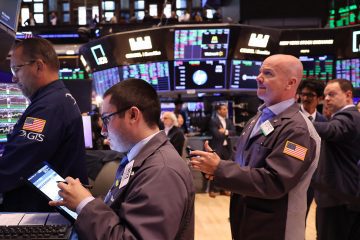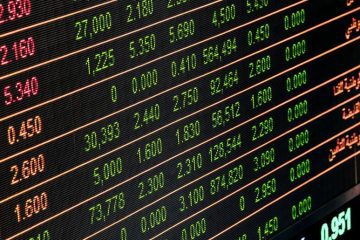Step back in time to the tumultuous year of 1987, where the whispers of financial uncertainty whispered through the bustling streets of Wall Street. The stock market crash of 1987, also known as Black Monday, sent shockwaves across the globe, leaving investors and experts alike questioning the very foundation of modern finance. Join us on a journey to explore the events, factors, and aftermath of this historic event that reshaped the landscape of the stock market as we knew it. Buckle up as we delve into the highs, lows, and lessons learned from the unforgettable stock market crash of 1987.
Table of Contents
- Understanding the Historical Context of the 1987 Stock Market Crash
- Key Factors Contributing to the 1987 Stock Market Collapse
- Lessons Learned from the 1987 Stock Market Crash
- Strategies to Mitigate Risks in Today’s Market Environment
- Q&A
- Closing Remarks
Understanding the Historical Context of the 1987 Stock Market Crash
The events leading up to the 1987 stock market crash were embedded in a complex web of economic, political, and social factors. One significant factor was the rapid expansion of the stock market in the preceding years, fueled by the optimism surrounding the booming economy. This exuberance created a bubble that eventually burst, leading to a swift and severe market correction.
Moreover, geopolitical tensions, such as the ongoing U.S.-Iran conflict and trade imbalances with Japan, added to the uncertainty in the financial markets. Investors began to fear an impending crisis, prompting a wave of panic selling that exacerbated the downturn. In the aftermath of the crash, regulatory measures were implemented to prevent such extreme fluctuations in the future, marking a pivotal moment in the history of financial markets.

Key Factors Contributing to the 1987 Stock Market Collapse
In retrospect, several key factors emerged as pivotal in the catastrophic downfall of the stock market in 1987. One notable element was the rapid influx of computerized trading systems, known as “program trading,” which amplified market volatility.
Moreover, the lack of circuit breakers or mechanisms to halt trading during sharp declines exacerbated panic selling. This absence of safeguards allowed the market freefall to spiral out of control, triggering widespread fear and uncertainty among investors.


Lessons Learned from the 1987 Stock Market Crash
Reflecting on the historic stock market crash of 1987 unveils invaluable insights that continue to resonate with investors and analysts alike. One crucial lesson learned is the significance of **risk management**. The sudden and drastic decline in stock prices during the crash highlighted the necessity of diversification and hedging strategies to mitigate potential losses.
Another key takeaway from the 1987 market plunge is the impact of **market psychology** on investment behavior. The crash demonstrated how fear and panic among investors can trigger massive sell-offs, leading to further market declines. Understanding the role of emotions in trading decisions is essential for navigating volatile market conditions and maintaining a rational investment approach.


Strategies to Mitigate Risks in Today’s Market Environment
In the fast-paced world of stock trading, seasoned investors and newcomers alike are constantly seeking ways to navigate the ever-changing landscape of market risks. By adopting a proactive approach and implementing effective strategies, individuals can better position themselves to weather the storms that might arise in today’s volatile market environment.
Diversification: One key strategy to mitigate risks is by diversifying your investment portfolio. By spreading your investments across various asset classes such as stocks, bonds, and real estate, you can reduce the impact of market fluctuations on your overall wealth. This approach helps cushion the effects of any single market downturn and enhances your chances of long-term financial success.
Stress Testing: Another valuable tactic is to stress test your investment portfolio under different market scenarios. By simulating potential market shocks and assessing how your investments perform under adverse conditions, you can identify vulnerabilities and make informed decisions to strengthen your portfolio’s resilience. This foresight allows you to adjust your risk exposure and optimize your risk-reward balance for a more secure investment future.
| Asset Class | Allocation (%) |
|---|---|
| Stocks | 60 |
| Bonds | 30 |
| Real Estate | 10 |
Q&A
**Q: What Caused the Stock Market Crash of 1987?**
A: The Stock Market Crash of 1987, also known as Black Monday, was triggered by a combination of factors. Some key reasons behind the crash include overvaluation of stocks, program trading strategies gone awry, and geopolitical tensions like the Iran-Contra scandal.
Q: How Did Investors React to the 1987 Stock Market Crash?
A: Investors were understandably shaken by the sudden and steep decline in stock prices. Many panicked and sold their holdings, exacerbating the downward spiral of the market. However, seasoned investors who maintained a long-term perspective saw it as an opportunity to buy undervalued assets.
Q: What Lessons Can We Learn from the Stock Market Crash of 1987?
A: The 1987 crash taught us the importance of portfolio diversification, risk management, and not succumbing to herd mentality. It highlighted the risks associated with excessive speculation and the need for a balanced approach to investing.
Q: Did the Stock Market Recover After the 1987 Crash?
A: Surprisingly, despite the severity of the crash, the stock market did recover relatively quickly. Within two years, stock prices had surpassed their pre-crash levels, demonstrating the resilience of the financial markets.
Q: How Did the 1987 Stock Market Crash Impact the Global Economy?
A: The repercussions of the 1987 crash were felt beyond the stock market, as it had a ripple effect on the global economy. It led to a slowdown in economic growth, increased volatility in financial markets, and prompted policymakers to reassess regulations around trading practices.
Closing Remarks
As we reflect on the tumultuous events of the 1987 stock market crash, it serves as a stark reminder of the unpredictability inherent in the world of finance. The lessons learned from this historic event continue to shape the way we approach investing and risk management today. Looking back at the resilience shown in the aftermath of the crash, we are reminded of the ability of markets to recover and adapt. History has a unique way of guiding us towards a more informed future. May we carry these insights forward as we navigate the ever-changing landscape of the stock market with caution, wisdom, and a keen eye on the lessons of the past.




0 Comments